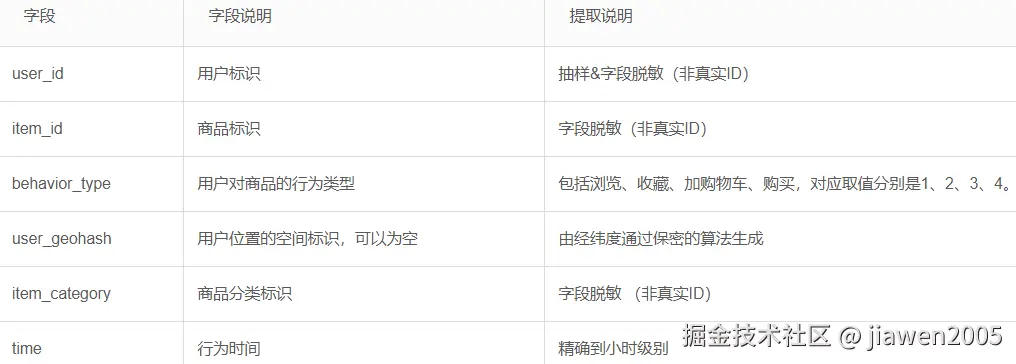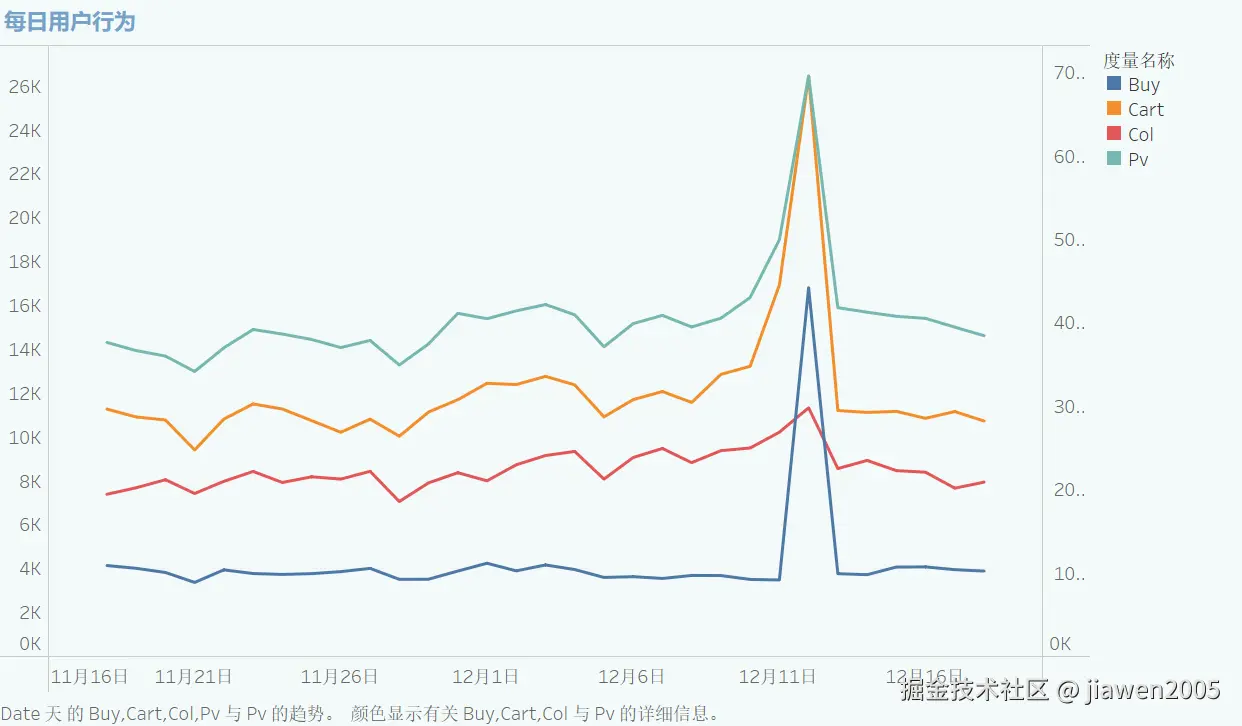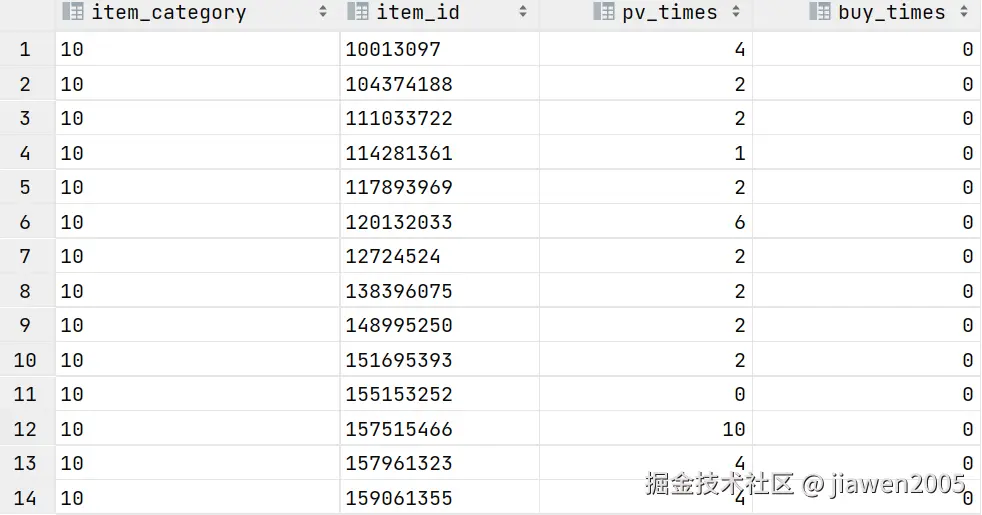本项目以阿里巴巴移动电商平台的真实用户-商品行为数据为基础,使用SQL进行数据清洗,以AARRR模型、RFM模型为基础展开分析,再用Tableau做可视化,最后从提升用户活跃度、促进商品成交、差异化用户营销三个方面提出建议。
首先理清思路,这是我的思维导图:

一、数据源
数据来自天池竞赛:
tianchi.aliyun.com/dataset/dat...
数据包含两部分,第一部分是用户在商品全集上的移动端行为数据,第二部分是商品子集。我只用到了第一部分。对应文件是tianchi_mobile_recommend_train_user.zip,包含如下字段:
 注意:这个文件解压后有560MB,数据有130万条多,很大,Excel打不开,还把我电脑卡死机了。
注意:这个文件解压后有560MB,数据有130万条多,很大,Excel打不开,还把我电脑卡死机了。
二、数据清洗
2.1 导入数据到数据库
我是买了一个阿里云的云端数据库,用起来比较方便,我买的2核2G,有点带不动,处理起来有点慢,但也能用。 导入数据时,所有字段都按varchar(255)导入,尤其是time字段,不要改成datetime,导入后会显示不出来,很麻烦。
2.2 异常值
查看time范围,behavior_type的类型。代码如下:
sql
select min(time),max(time)
from data;
select distinct behavior_type
from data;

2.3 缺失值
查看各字段数量,全部一样,没有缺失值。代码如下:
sql
select count(user_id),count(item_id),
count(behavior_type),count(time)
from data; #13309161
2.4 数据一致化
将time字段分成 日期date和时段hours两个字段,把behavior_type的数字改为英文简写,方便理解。代码如下:
sql
# 将time分成date和hours两个字段,然后删除time
alter table data add column date date;
alter table data add column hours varchar(255);
update data set date = left(time,10);
update data set hours = substring(time,12,2);
# 把behavior_type 分别改为 pv,col,cart,buy
update data
set behavior_type = (
case
when behavior_type = 1 then 'pv'
when behavior_type = 2 then 'col'
when behavior_type = 3 then 'cart'
when behavior_type = 4 then 'buy'
else '其他'
end
);
# 删除time这一列
alter table data drop time;三、数据分析
理解业务,写代码,建视图,可视化
3.1 用户获取(Acquisition)
代码参考后面的留存率day_0
3.2 用户激活(Activation)
PV,UV
本项目数据源共13309161条,PV有12540816条,UV有9994条,人均页面访问数为1254.83。代码如下:
sql
#pv 页面浏览量 uv 独立访客数
create view whole_index as
select sum(user_pv) PV,
count(user_id) UV,
# 人均页面访问数 PV/UV
format(sum(user_pv)/count(user_id),2) 人均页面访问数
from
(
select user_id,count(behavior_type) user_pv
from data
where behavior_type = 'pv'
group by user_id
) a;
跳失率
浏览页跳失率为5.06%,关键页跳失率64.98%。
跳失分析:商品不符合用户需求,竞争力不够。可对比竞品网站,在商品的定价、商品陈列故事、商品详情描述等方面做出改进。 代码如下:
sql
# 浏览页跳失率
create view view_bounce_rate as
select
(
select count(distinct user_id)
from data
) 总用户,
count(distinct user_id) 仅pv用户,
concat(format(count(distinct user_id)/(select count(distinct user_id) from data)*100,2),'%') 浏览页跳失率
from data
where user_id not in
(
select distinct user_id
from data
where behavior_type = 'col'
)
and user_id not in
(
select distinct user_id
from data
where behavior_type = 'cart'
)
and user_id not in
(
select distinct user_id
from data
where behavior_type = 'buy'
);
select * from view_bounce_rate;
sql
# 关键页跳失率:用户有收藏或加购,但无购买
create view key_bounce_rate as
select
(
select count(distinct user_id)
from data
) 总用户,
count(distinct user_id) col_cart用户,
concat(format(count(distinct user_id)
/(
select count(distinct user_id)
from data
)*100,2),'%') 关键页跳失率
from data
where user_id in
(
select distinct user_id
from data
where behavior_type = 'col'
)
or user_id in
(
select distinct user_id
from data
where behavior_type = 'cart'
)
and user_id not in
(
select distinct user_id
from data
where behavior_type = 'buy'
);
select * from key_bounce_rate;
时间维度用户行为
从时间维度的日期、时段、星期,来观察用户行为。代码如下:
sql
# 每日、小时用户行为
create view dayhour_behavior_times as
select date,hours,
sum(case when behavior_type = 'pv' then 1 else 0 end) pv,
sum(case when behavior_type = 'col' then 1 else 0 end) col,
sum(case when behavior_type = 'cart' then 1 else 0 end) cart,
sum(case when behavior_type = 'buy' then 1 else 0 end) buy,
count(behavior_type) all_click,
count(distinct user_id) all_users
from data
group by date,hours
order by date,hours;
select * from dayhour_behavior_times; 从11月30日开始,pv、cart值增大,12月5日、8日出现小范围减小;12月12日当天pv、cart、buy值激增,达到高点,次日骤降,回归平均水平。
从11月30日开始,pv、cart值增大,12月5日、8日出现小范围减小;12月12日当天pv、cart、buy值激增,达到高点,次日骤降,回归平均水平。 
从日时段来看,用户在10点到24点较为活跃。从17点开始逐渐增高,晚上21点---22点达到最高值。 
sql
# 周weeks用户行为,'%W' W必须大写,才会返回星期名。
create view weeks_behavior_times as
select date_format(date,'%W') weeks,
sum(case when behavior_type = 'pv' then 1 else 0 end) pv,
sum(case when behavior_type = 'col' then 1 else 0 end) col,
sum(case when behavior_type = 'cart' then 1 else 0 end) cart,
sum(case when behavior_type = 'buy' then 1 else 0 end) buy,
count(behavior_type) all_click,
count(distinct user_id) all_users
from data
where date between '2014-11-23' and '2014-12-13'
group by weeks
order by field(weeks,'Monday','Tuesday','Wednesday', 'Thursday', 'Friday', 'Saturday', 'Sunday');
从星期来看,周四、周五、周六形成一个客流小高峰,在周五完成购买。 
3.3 用户留存(Retention)
留存率
为了排除11月18日前,未统计数据的影响。选择近一个月的中间日期,从12月3日开始看用户留存率。代码如下:
sql
create view time_inter as
select a.*,b.firstday,datediff(a.date,b.firstday) day_diff
from
(
select user_id,date
from data
group by user_id,date
) a,
(
select user_id,min(date) firstday
from data
group by user_id
) b
where a.user_id = b.user_id
order by user_id,date;
sql
# 搭建留存天数模型retention_day,第一次活跃用户会持续活跃几天
create view retention_day as
select firstday,
sum(case when day_diff = 0 then 1 else 0 end) day_0,
sum(case when day_diff = 1 then 1 else 0 end) day_1,
sum(case when day_diff = 2 then 1 else 0 end) day_2,
sum(case when day_diff = 3 then 1 else 0 end) day_3,
sum(case when day_diff = 4 then 1 else 0 end) day_4,
sum(case when day_diff = 5 then 1 else 0 end) day_5,
sum(case when day_diff = 6 then 1 else 0 end) day_6,
sum(case when day_diff = 7 then 1 else 0 end) day_7,
sum(case when day_diff = 15 then 1 else 0 end) day_15,
sum(case when day_diff = 30 then 1 else 0 end) day_30
from time_inter
group by firstday
order by firstday;
sql
# 搭建留存率模型retention_rate
create view retention_rate as
select firstday,day_0,
concat(format(day_1/day_0*100,2),'%') day_1,
concat(format(day_2/day_0*100,2),'%') day_2,
concat(format(day_3/day_0*100,2),'%') day_3,
concat(format(day_4/day_0*100,2),'%') day_4,
concat(format(day_5/day_0*100,2),'%') day_5,
concat(format(day_6/day_0*100,2),'%') day_6,
concat(format(day_7/day_0*100,2),'%') day_7,
concat(format(day_15/day_0*100,2),'%') day_15,
concat(format(day_30/day_0*100,2),'%') day_30
from retention_day;
12·12活动前后的用户留存率高于同期水平。从留存率看,预计12月18日后近期会有另外的促销活动开展。
3.4 用户推荐(Referral)
本项目中的收藏col与加购cart的行为不是相互独立的,都是确定购买buy意向的行为,没有先后之分。因此,从浏览pv、加购cart、购买buy这一路径来简要分析。
从浏览到加购的转化率为2.98%,用户花了大量时间寻找合适的产品。可优化网站筛选、关键词搜索功能,推荐更适合用户的商品,方便用户迅速获取信息。
从加购到购买的转化率约为35%。可针对加购未购买产品细分,采用提供优惠券、推荐同款商品等促销方法。
转化率
代码如下:
sql
# 计算转化率conversion_rate
create view conversion_rate as
select
concat(format(
(
select count(behavior_type)
from data
where behavior_type = 'col'
)/
(
select count(behavior_type)
from data
where behavior_type = 'pv'
)*100,2),'%') 收藏转换率,
concat(format(
(
select count(behavior_type)
from data
where behavior_type = 'cart'
)/
(
select count(behavior_type)
from data
where behavior_type = 'pv'
)*100,2),'%') 购物车转换率,
concat(format(
(
select count(behavior_type)
from data
where behavior_type = 'buy'
)/
(
select count(behavior_type)
from data
where behavior_type = 'pv'
)*100,2),'%') 购买转换率
漏斗模型
用户行为漏斗behavior_times,uv独立访客漏斗user_times。代码如下:
sql
# 漏斗模型
create view funnel_times as
select behavior_type,count(behavior_type) behavior_times,
count(distinct user_id) user_times
from data
group by behavior_type
order by field(behavior_type,'pv','col','cart','buy');
3.5 用户收益(Revenue)
购买率
代码如下:
sql
# 创建视图user_behavior_times,用户-行为分类明细表
create view user_behavior_times as
select user_id,
sum(case when behavior_type = 'pv' then 1 else 0 end) pv_times,
sum(case when behavior_type = 'col' then 1 else 0 end) col_times,
sum(case when behavior_type = 'cart' then 1 else 0 end) cart_times,
sum(case when behavior_type = 'buy' then 1 else 0 end) buy_times,
concat(format(sum(case when behavior_type = 'buy' then 1 else 0 end)
/sum(case when behavior_type = 'pv' then 1 else 0 end)*100,2),'%') 购买率,
sum(case when behavior_type = 'buy' then 1 else 0 end)
/sum(case when behavior_type = 'pv' then 1 else 0 end) sort
from data
group by user_id
order by sort desc;
复购率
代码如下:
sql
# 复购率
create view repurchase_rate as
select concat(format(
(
select count(user_id)
from user_behavior_times
where buy_times>1
)/
(
select count(user_id)
from user_behavior_times
where buy_times>0
)*100,2),'%') 复购率;
2.商品销售情况
查看各品类及商品被购买次数,包括0次即没有成交记录,在可视化时可以,计算商品购买率,并按照需要筛选相应指标。代码如下:
sql
create view hot_item as
select item_category,item_id,
sum(case when behavior_type = 'pv' then 1 else 0 end) pv_times,
sum(case when behavior_type = 'buy' then 1 else 0 end) buy_times
from data
group by item_category,item_id
order by item_category,item_id,buy_times; 可视化:
可视化:

3.用户价值(基于RFM模型)
仅在会员(购买过商品的用户)范围内,进行价值划分,R/F等级为1-5,由于本项目的数据不涉及M(Monetary),所以只做4类划分。
通过RFM模型,了解每位顾客的特性,实现差异化营销。
- 重要价值用户,R高F高。经常在网站购物,并形成习惯,做好维护即可。
- 重要深耕用户,R高F低。这类用户粘性不强,近期有消费行为,可能是针对需要的商品直接下单,不会过于频繁地进行其他商品的浏览、购买。可推荐更符合用户喜好、性价比高商品,吸引其进行购买,逐渐建立消费习惯。
- 重要唤回用户,R低F高。最近没有购买行为,可以通过短信等场外提醒,引导其入场参与优惠活动,尽快完成下次购买行为。
- 重要挽留用户,R低F低。该类用户容易流失,占比40.02%,可提升空间大,运营活动可重点针对这部分用户,通过拼团打折、积分兑换、捆绑销售等活动唤起用户注意力,提升用户兴趣。
代码如下:
sql
# 计算R/F/M,本项目无M,省略
create view rfm as
select user_id,
max(date) as 'lasttime',datediff('2014-12-19',max(date)) recency,
count(behavior_type) frequency,
(
case
when datediff('2014-12-19',max(date))<=3 then 5
when datediff('2014-12-19',max(date))<=6 then 4
when datediff('2014-12-19',max(date))<=9 then 3
when datediff('2014-12-19',max(date))<=12 then 2
else 1 end
) R,
(
case
when count(behavior_type)<=2 then 1
when count(behavior_type)<=4 then 2
when count(behavior_type)<=6 then 3
when count(behavior_type)<=8 then 4
else 5 end
) F
from data
where behavior_type = 'buy'
group by user_id;
sql
# 计算平均值
select avg(F) F平均值
from rfm; #3.7771
select avg(R) R平均值
from rfm; #3.3687
sql
# 没有M,建立在购买量M大的前提下,对用户做出以下4类分类
create view rfm用户分类 as
select *,
(
case
when R>3.3687 and F>3.7771 then '重要价值用户'
when R>3.3687 and F<3.7771 then '重要深耕用户'
when R<3.3687 and F>3.7771 then '重要唤回用户'
when R<3.3687 and F<3.7771 then '重要挽留用户'
end
) 用户分类
from rfm; 可视化:
可视化:

4.导出数据
右键视图,选择将数据导出到文件,导出到合适的文件夹。大概半小时左右即可导出成功。一定要选择添加列标题,方便可视化。


四、可视化看板
 主要分为三部分,第一部分是整体用户行为分析,可行建议有:对比竞品网站,在商品的定价、商品陈列故事、商品详情描述等方面做出改进,减少用户跳失。 大型活动至少提前1---2周进行预热,可活跃用户,提升用户留存率;网站维护、客服尤其要关注晚上20点---23点时段;日常的推新、促销可选择在周四至周六这一时间段进行。 优化网站筛选、关键词搜索功能,推荐更适合用户的商品,方便用户迅速获取信息;针对加购未购买产品细分,采用提供优惠券、推荐同款商品等促销方法,提升用户行为转化率,促进更快、更顺利完成购买行为。
主要分为三部分,第一部分是整体用户行为分析,可行建议有:对比竞品网站,在商品的定价、商品陈列故事、商品详情描述等方面做出改进,减少用户跳失。 大型活动至少提前1---2周进行预热,可活跃用户,提升用户留存率;网站维护、客服尤其要关注晚上20点---23点时段;日常的推新、促销可选择在周四至周六这一时间段进行。 优化网站筛选、关键词搜索功能,推荐更适合用户的商品,方便用户迅速获取信息;针对加购未购买产品细分,采用提供优惠券、推荐同款商品等促销方法,提升用户行为转化率,促进更快、更顺利完成购买行为。
第二部分是对商品品类的分析,可行建议有:在成交品类较高的6977、5232、13500等大类后,可设置引流通道。对成交量高的品类,提炼可复用的营销方法。 对pv低buy低的商品,可增加其客流量,以期提高成交量;在活动中把pv低buy高的商品作为主打,提高复购率,打开市场、吸引新用户,借其增强品类口碑;针对pv高buy低的商品,在商品详情、价格等方面做出改变,提升商品竞争力;提炼pv高buy高的商品卖点、精简描述,引导用户更快做出购买决策,提升购买体验。
第三部分是对用户特性的分析,细分每一类用户,做好差异化营销。可行建议有:做好 重要价值用户 的维护工作,推荐更符合 重要深耕用户 喜好、性价比高商品,吸引其进行购买,逐渐建立消费习惯。通过发送短信等场外提醒给 重要唤回用户 的方式,引导其入场参与优惠活动,尽快完成下次购买行为。运营活动可重点关注容易流失的 重要挽留用户 ,通过拼团打折、积分兑换、捆绑销售等活动唤起用户注意力,帮助用户建立对平台的兴趣。